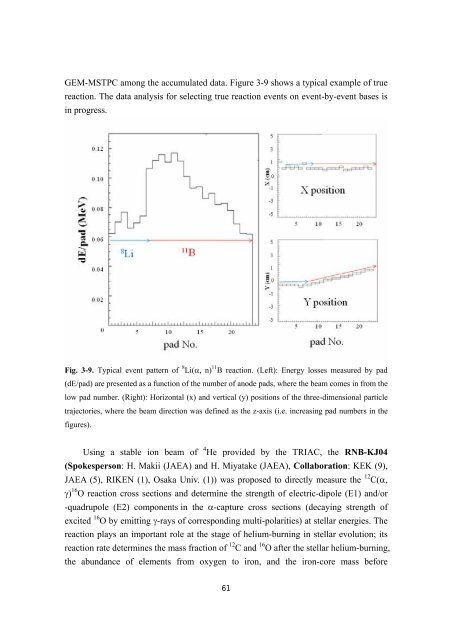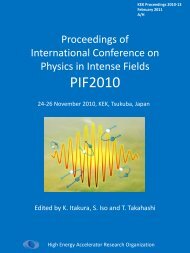TRIAC Progress Report - KEK
TRIAC Progress Report - KEK
TRIAC Progress Report - KEK
You also want an ePaper? Increase the reach of your titles
YUMPU automatically turns print PDFs into web optimized ePapers that Google loves.
GEM-MSTPC among the accumulated data. Figure 3-9 shows a typical example of true<br />
reaction. The data analysis for selecting true reaction events on event-by-event bases is<br />
in progress.<br />
Fig. 3-9. Typical event pattern of 8 Li(α, n) 11 B reaction. (Left): Energy losses measured by pad<br />
(dE/pad) are presented as a function of the number of anode pads, where the beam comes in from the<br />
low pad number. (Right): Horizontal (x) and vertical (y) positions of the three-dimensional particle<br />
trajectories, where the beam direction was defined as the z-axis (i.e. increasing pad numbers in the<br />
figures).<br />
Using a stable ion beam of 4 He provided by the <strong>TRIAC</strong>, the RNB-KJ04<br />
(Spokesperson: H. Makii (JAEA) and H. Miyatake (JAEA), Collaboration: <strong>KEK</strong> (9),<br />
JAEA (5), RIKEN (1), Osaka Univ. (1)) was proposed to directly measure the 12 C(α,<br />
γ) 16 O reaction cross sections and determine the strength of electric-dipole (E1) and/or<br />
-quadrupole (E2) components in the α-capture cross sections (decaying strength of<br />
excited 16 O by emitting γ-rays of corresponding multi-polarities) at stellar energies. The<br />
reaction plays an important role at the stage of helium-burning in stellar evolution; its<br />
reaction rate determines the mass fraction of 12 C and 16 O after the stellar helium-burning,<br />
the abundance of elements from oxygen to iron, and the iron-core mass before<br />
61













